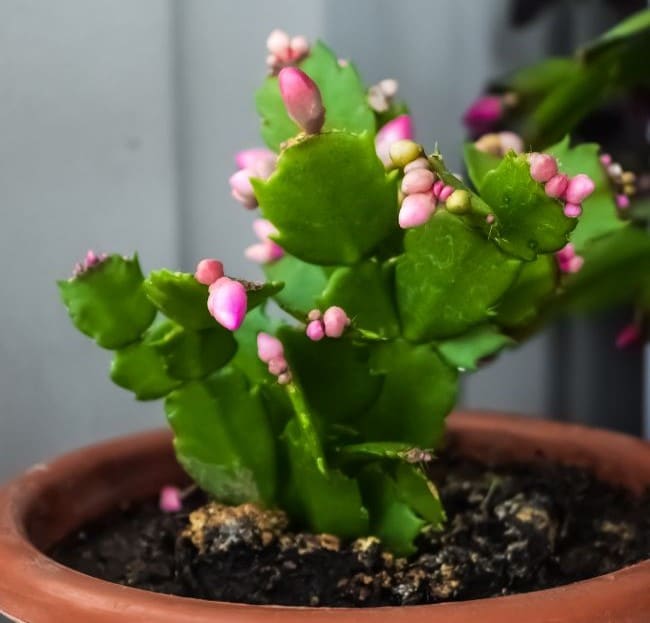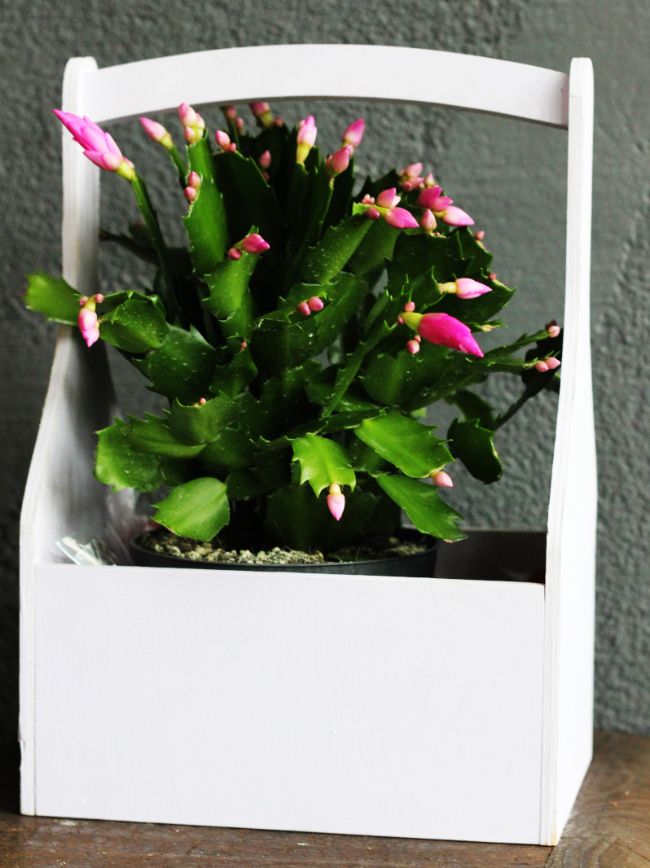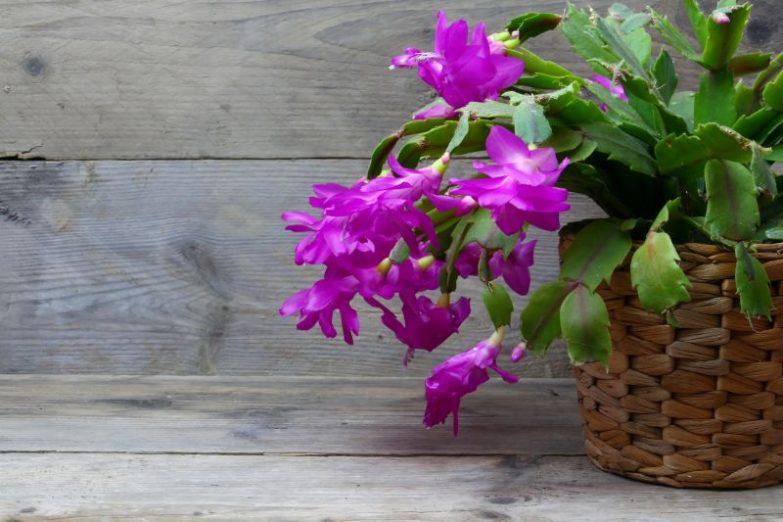There are multiple reasons to love the Christmas Cactus (Schlumbergera) – these plants are gorgeous, they bloom in the holiday season when most other plants aren’t looking their best, and they keep blooming year after year for decades. No wonder then that the sight of a Christmas Cactus dropping leaves will be a cause of concern.
The most common cause of a Christmas Cactus dropping leaves is overwatering, or conditions that result in soggy soil conditions. This causes root rot, and damage to the rest of the plant. Poorly draining soil, temperature stress, overfertilizing, lighting problems, or pests can also cause leaf drop.
Why Christmas Cacti Drop Their Leaves
Christmas Cacti (Schlumbergera) are native to the tropical rainforests of Brazil. These plants are normally grown in greenhouses where they are exposed to surroundings that greatly resemble their natural habitat in terms of lighting, humidity, and temperature. But once inside your home, the conditions may not be as ideal, which might stress the plant and cause leaf drop.
So the key is to pinpoint the problem and then fix it to ensure your Christmas Cactus stays in perfect health. The advice in this article is equally applicable to all types of holiday cactus, so whether you’ve got a Thanksgiving Cactus, Christmas Cactus, or Easter Cactus, this article can help.
Reasons Why Your Christmas Cactus Is Dropping Leaves
Overwatering
This is the biggest mistake most people make when it comes to caring for the Christmas Cactus. Yes, it does require more water than its desert brethren, but you should remember that it is called ‘Cactus’ for a reason.
Overwatering results in root rot, which in turn causes the plant to drop leaves. Several factors may contribute to overwatering, including poorly draining soil, a pot with insufficient drainage holes, a container that is too large, etc. These factors may lead to root rot as a result of water saturating the soil for long periods of time.
It is also important to consider the temperature around the plant and the amount of light it is getting. If your plant is in low light, or during the fall and winter months, the plant will grow much more slowly, and the water requirements of your Christmas Cactus will be greatly reduced.
Why Does Overwatering Result In My Christmas Cactus Dropping Leaves?
During the first stage of overwatering, the trunk and branches of your Christmas Cactus will absorb more water than they need. This can lead to edema of the leaf tissue and damage to the plant itself. This alone can result in some leaf drop, but can also increase the risk of infection and pests, which can result in the plant dropping leaves (branches).
Further overwatering and soggy soil conditions will result in root rot. Once root rot sets in, the plant has no way of absorbing essential water and nutrients to keep the rest of the plant healthy. This will lead to the plant shedding some of its leaves, typically older, lower leaves first, as the plant enters survival mode.
How To Fix This?
If your Christmas Cactus is dropping leaves, check for signs of root rot. Gently slide the plant out of the pot and inspect the roots. Rotten roots will be brown/black, mushy, and fragile. They may also smell bad too. If root rot is present, follow these steps to save your plant.
- Gently remove all loose soil from around the roots. I often use a basin of water to remove all the soil from around the roots.
- Use a pair of sterile pruners to remove all roots affected by root rot.
- If you need to remove a large portion of the roots, you should also prune the plant back a proportionate amount, so the healthy roots are able to support the remaining plant.
- You may like to spray the roots with a fungicidal preparation, to reduce the risk of recurrence of root rot.
- Choose a new pot that is just large enough for the plant and one that has plenty of drainage holes.
- Well draining potting mix is essential for preventing root rot. A mix of 1/3 succulent mix, one-third houseplant potting mix, and 1/3 perlite or coarse sand is a good option.
- Make sure to provide moderate growing conditions for your plant after repotting, to reduce stress and allow the plant to slowly recover.
Preventing Christmas Cactus Leaf drop From Overwatering
The best way to determine when your Christmas Cactus needs a drink is to check the top layer (1-2 inches) of the soil. If it feels dry to touch, it is time to water the plant.
Make sure to thoroughly and evenly wet the soil when watering, but allow plenty of time for excess water to drain out of the drainage holes to prevent the plant from sitting in soggy soil.
Remember to empty the drip tray after a while, or leave your plant somewhere to drain before putting it back in its normal spot.
Don’t water on a schedule, but monitor the dampness of the soil with your finger every few days and water your Christmas Cactus when the top 1-2 inches of the soil feels dry. Read this article to learn more about how to get houseplant watering just right.

Underwatering
Just because it is called the Christmas ‘Cactus’ this does not mean that this plant can go for long periods of time without any water. So if you’re giving too little water to your Christmas Cactus thinking that it will survive the drought, you are sadly mistaken.
A plant that is not getting the moisture that it needs to thrive and is constantly drought-stressed is likely to drop leaves due to dehydration. It is also less likely to bloom.
How To Fix This?
The simple way to fix underwatering is to obviously water the plant. If the soil seems bone dry, make sure the water properly penetrates it and reaches the root ball of the plant.
Another idea to rehydrate your plant would be to let the container sit in a dish filled with water for about 10-15 minutes to let the roots soak in the moisture nicely.
Bear in mind that your plant will need watered more frequently in the summer when the plant is growing more quickly, light is more intense and temperatures are higher.
Lighting Issues
Christmas Cacti naturally grow in the dense rainforests of Brazil under the shade of tree canopies and larger plants. As a result, it has adapted to grow and thrive in bright, indirect light, and will not tolerate direct sunlight, unlike many other varieties of cactus.
If you have placed your plant in an area that receives direct sunlight for the better part of the day, it will scorch its leaves and induce leaf dropping.
Keeping the plant in a shaded spot is less likely to cause any serious issues.
How To Fix This?
Your Christmas Cactus will be happiest when placed in an area that gets lots of bright but indirect light. Read my article about lighting for houseplants to learn more where to put your plants in your home to help them thrive.
Over-Fertilizing
Over-fertilizing is another common mistake to make when caring for houseplants. It’s so tempting to add a little too much or fertilize too frequently in a well-meaning attempt to get your plant to grow more quickly and look more impressive.
Sadly, all this love translates into a slow death for the poor Christmas Cactus because over-fertilizing badly damages the roots of the plant. Let me explain how.
Fertilizer for plants is like vitamins for humans. Plants get their main food from sunlight, but nutrients from the soil provide small amounts of essential elements.
A little fertilizer helps them grow and thrive, but larger amounts are toxic to the plant. This can cause a range of symptoms, but most commonly brown patches on the leaves, or leaf drop.
In addition, when there is too much fertilizer salt build-up in the soil due to over-fertilizing, this can cause toxicity in the roots, preventing them from functioning and being able to absorb water and nutrients for the plant.
The result – roots start getting dehydrated and eventually die off, thereby triggering serious leaf drop.
How To Fix This?
Look for evidence of white crusts on the top of the soil, indicating nutrient build-up. Also, think about how much and how frequently you have been fertilizing your plant over the last while.
If you suspect that your Christmas Cactus is dropping leaves due to over-fertilizing, there are two potential solutions.
- Flush the soil with copious quantities of water for 5 minutes to dissolve excess fertilizer salts and wash them out of the soil. Then avoid fertilizing for at least 6 months to allow the plant to recover.
- Gently remove the plant from the pot and check for any damaged roots. Prune the damaged roots, if any, and give the rest a thorough rinse to wash off the excess salt build-up. Now pot the plant in fresh potting mix.
Ideally, a Christmas cactus should be fed monthly – but only from April to September. You can use any balanced, all-purpose houseplant fertilizer. It requires no feeding in the fall and winter months when it is blooming. Read my guide to fertilizing houseplants to learn more about this important aspect of plant care.

Temperature Changes
If you think that your Christmas Cactus is not suffering from any of the above-mentioned issues, then maybe it is being exposed to too much cold or heat, causing its leaves to drop. Here are some common reasons where temperature stress can result in your Christmas Cactus dropping leaves;
- When you first bring your Christmas Cactus home. Temperature changes during transport or at the plant store can cause leaf drop.
- If you grow your Christmas Cactus outside during the summer and forget to bring it indoors as the cooler autumn nights approach.
- If your Christmas Cactus is placed near a source of hot or cold drafts, such as an air conditioning vent, radiator, or near a drafty window.
How To Fix This?
Make sure your Christmas Cactus is exposed to temperatures in the range of 65-85°F (18-29°C) in the summer months, and slightly less in the winters. Never let the temperature fall below 50°F (10°C).
Also, keep the plant away from any cold or hot air vents, or cold drafts from windows as sudden changes in temperature will stress the plant.
Leaf drop due to temperature stress is temporary and will stop once your plant adjusts to its new environment.
Pests
Although Christmas Cacti are fairly resistant to pests, they can sometimes get infested by mealybugs, aphids, or spider mites. A major infestation is likely to seriously harm the plant and induce leaf drop.
Mealybugs can be identified as small spots of white cotton during the initial stages of infestation. They usually appear on the lower side of the leaf or at the joints of the leaves and stems.
Aphid infestation starts on new growth or on the underside of the leaves. These pests suck the sap from the leaves and leave sticky honeydew residue on the plant’s surface that attracts mold.
If you start noticing fine silken webbing on the leaves of your Christmas cactus, it is a warning sign that it might be infested by spider mites. These pests are invisible to the naked eye.
How To Fix This?
The best way to tackle a mild pest infestation is to try to dislodge the pests by a forceful water spray. If this method does not work, you can use insecticidal soap or neem oil spray to get rid of the pests. Mealybugs can be removed using a soft toothbrush.
Another method to tackle pests like mealybugs, spider mites, and aphids is to blot them with alcohol-soaked cotton balls. Read my guide to identifying, treating, and preventing houseplant pests to learn more.
Please remember to isolate your Christmas Cactus from other houseplants as soon as you notice signs of pest infestation. In cases of severe infestation, you might be forced to discard your plant.
Pro Tip
There is one silver lining if you see your Christmas Cactus dropping leaves. These so-called leaves of the plant are actually segmented branches – so if the dropped ‘leaves’ look healthy enough, you can plant them in a new container.
Hopefully, the universe will conspire in your favor, and the dropped leaves will start taking root!

